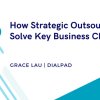From pandemics to plant explosions, cyberthreats and scarce natural resources, the risks facing a supply base have never been so stark. Now is the time for companies to improve long-term resilience.
As the world gets to grips with a world health and humanitarian emergency resulting from the spread of coronavirus (COVID19), the knock-on economic effects also take effect. In an increasingly global economy, we are starting to see how fragile some just-in-time supply chains have become.
Impacts of Disruption
Disruptions to industrial outputs can cause global supply chains to slow, as access to finished goods and components become constrained. As current supply agreements and strategies are challenged, there is the potential of escalating additional costs to organizations as they are forced to adapt and level out again. As we saw with COVID-19, what starts with reduced manufacturing output in China leads to depleted supplies and cancelled activities and travel across the world, meaning a wide spectrum of economic loss.
As an example, Britain’s largest car manufacturer Jaguar Land Rover admitted in February to having flown Chinese parts to the UK in suitcases in a scramble to keep production running. The company, which makes nearly 400,000 vehicles a year at its three factories in the U.K., warned it could run out of parts in just two weeks.
Indeed, many firms transcending all regions and sectors have experienced crippling supply chain issues as a result of the outbreak. According to Fortune, some 94% of Fortune 1000 companies are now seeing related supply chain disruptions.
COVID-19 has become the latest epidemic disruption, affecting supply chains through factors including lack of access to markets, materials and importantly, staff. Supply chain leaders are now in the position to re-assess their approaches and put in place strategies to rapidly respond to an epidemic disruption.
A Trend of Mounting Risks
Undoubtedly, disruptions like COVID-19 have a greater magnitude today because supply chains have changed dramatically in recent years. Top threats impacting global supply chains have recently included plant explosions or fires, natural disasters, cyberthreats, distribution disturbances, government intervention, and demographic changes in workforce and logistical execution.
In terms of dangers, the numbers speak for themselves. Resilinc’s Annual EventWatch Report, which offers global supply chain risk event intelligence, reported a 36% increase in hazardous events in 2018. That is an average of seven supply chain risk events happening every day.
Supply Chain Management Review Editor Bridget McCrea, notes, “Last year was the fourth-costliest year since 1980 in terms of insured losses, primarily due to an accumulation of severe and costly events in the second half of the year.” She referenced data from Munich Re, one of the world’s most comprehensive databases for analyzing and evaluating natural catastrophes, in its NatCatSERVICE report.
For example, climate and geological events such as hurricanes and wildfires, continue to hinder and unravel global supply chains. In 2018, there were 850 natural disasters registered worldwide. Nearly half (42%) were in Asia, followed by North America with 20%, Europe with 14% and Africa with 13%.
Proactively Reducing Risk
While the threats facing procurement leaders and their supply base will likely continue to rise, the acute risk is the gaps for purchasers to find and source alternative suppliers quickly and to accurately navigate a challenged supply chain.
Returning to the example of Jaguar Land Rover, The Times reported in February that the company also planned to cease production of the I-Pace electric SUV for one week because of a battery shortage at supplier LG Chem. It reported this was at least the third time that a battery shortage at LG Chem has affected the production of an electric vehicle.
Shortage-fueled supply chain delays like the one JLR has experienced help illustrate that the big, multibillion-dollar plans manufacturers make for their products are only as sound as the suppliers they rely upon.
In a recent webinar hosted by scoutbee, Dan Mahlebashian, the former Global Executive Director & Chief Contracting Officer of General Motors, described the tedious, manual, time-intensive work procurement workers face in identifying and sourcing suppliers. This archaic approach to strategic sourcing remains the bottleneck limiting proactive strategic procurement for most organizations as they are constantly locked in reactive mode.
So what actions should procurement leaders and their teams take?
With COVID-19, many companies have enacted crisis management plans as part of a wider business continuity approach and a fast-changing situation means many are still focused on their immediate response. However, what should follow is organizations acting tactically to improve long term resilience. In fact, technology now offers both greater capability during instability and a better long-term position from which to face future events.
AI, Big Data and the Cloud to Digitize Supplier Scouting
Advanced technologies like artificial intelligence (AI),machine learning (ML), and cloud-based applications can provide unified information and inputs to identify suppliers faster, more strategically and with more resilience.
“Spend better and buy better—that’s the job of procurement,” Mahlebashian says. He cautions that only managing the “buying” imperative opens up additional risks—like paying too much, late shipments, inventory not aligned with consumption and demand forecasts.
The most innovative procurement leaders are now exploring AI-powered scouting technology. These tools help users to find, evaluate, vet and on-board suppliers globally for direct or indirect materials with greater speed and confidence.
Digital scouting platforms use constantly curated supplier information along with market data and can provide hundreds of data points on any vendor at the click of a button. Knowing more about your supply base, you can respond with agility to changing demands, and dynamically manage your category, pricing benchmarks and alternative suppliers.
In responding to crises, AI scouting technology now offers a shortened discovery and validation process with rapid access to financials, corporate and geographic news, corporate sustainability data along with active certifications. Users also gain visibility into critical certifications along with the ability to search across all your suppliers for specific data and information to sift through vast amounts of data quickly.
Source the Best — From Far and Wide with AI
With digital tools, procurement professionals can outline their scouting needs in as little as one hour. You can cast a wider digital net to identify all the potential suppliers, both current and potential, for your project. What normally takes months to find, validate and select a new supplier can now be done in a matter of weeks—ensuring you have the broadest view of the market.
Stronger Sourcing Decisions Using Unified Data
Review, pre-screen and develop the target list of suppliers to validate in about an hour, making it simple to review a wider set of potential suppliers with relevant details and a more holistic view. Given the larger set of potential candidates supplier discovery tools deliver, they also organize and help prioritize best-fit potentials to speed up the entire evaluation process.
Collaborate Rapidly
Reducing the friction between supplier selection and on-boarding is a catalyst in more strategic relationship management. You can use these tools to collaborate and validate suppliers through cloud-based communication channels to conduct secure conversations, eliminating redundant work or time-consuming email management.
Embracing a scout-to-source digital process can be done in a short timeframe. Evolving a corporate mindset on procurement by evolving the true value of “buying” and “spending” more proactively is an on-going journey. The most important thing to move this mindset forward is to go full steam ahead and show people why this approach works.
Key Takeaways
As supply chains become increasingly global, and the risk factors within them greatly more diverse, the ability to manage associated risk across geographic boundaries and timezones should now be a top priority for organizations.
Here are the top three recommendations for reducing supply chain vulnerability:
- Keep supply chains more secure through diversified supplier portfolios
- Be ready and equipped to react quickly to changes and prevent disruptions to production and customers
- Develop long term preferred core suppliers and/or help them to bounce back after crises or disruptions
Digitizing the scout-to-source process enables organizations to find new suppliers with more confidence, speed and transparency. All industries can now reduce supply chain risks and disruptive effects with a strategy that leverages digital sourcing.









